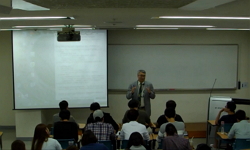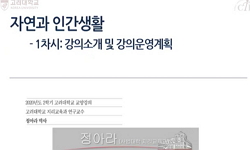Wild pollinators provide important pollination services for crops. However, their geographical ranges and impact on pollination services have not been fully explored within the scope of Korean agricultural land. This study aims to identify spatial sup...
http://chineseinput.net/에서 pinyin(병음)방식으로 중국어를 변환할 수 있습니다.
변환된 중국어를 복사하여 사용하시면 됩니다.
- 中文 을 입력하시려면 zhongwen을 입력하시고 space를누르시면됩니다.
- 北京 을 입력하시려면 beijing을 입력하시고 space를 누르시면 됩니다.

야생화분매개곤충 분포 모형을 활용한 과수원 수분 서비스 위험도 평가 = A Risk Assessment of Orchard Pollination Services using a Species Distribution Model for Wild Pollinators
한글로보기https://www.riss.kr/link?id=A107195701
- 저자
- 발행기관
- 학술지명
- 권호사항
-
발행연도
2020
-
작성언어
-
- 주제어
-
등재정보
KCI등재
-
자료형태
학술저널
- 발행기관 URL
-
수록면
29-41(13쪽)
-
KCI 피인용횟수
0
- DOI식별코드
- 제공처
-
0
상세조회 -
0
다운로드
부가정보
다국어 초록 (Multilingual Abstract)
Wild pollinators provide important pollination services for crops. However, their geographical ranges and impact on pollination services have not been fully explored within the scope of Korean agricultural land. This study aims to identify spatial supply-demand mismatches across orchard fields in the context of assessing pollination service risk. We first used National Ecosystem Survey data and a species distribution model (MaxEnt) to develop the geographic range of each of 32 wild pollinators belonging to three families (Diptera, Hymenoptera, and Lepidoptera). We then summed the modeled presence probability of each species to obtain a measure of spatially explicit pollinator richness. This modeled richness, defined as pollination supply, was compared with the summed area of orchard fields at the municipal boundary level to identify areas with supply-demand mismatches. The study found that Lepidoptera showed the highest species richness (8.3±1.5), followed by Hymenoptera (4.3±0.8) and Diptera (3.5±0.8) species. Median orchard area was 1.5 ㎢ (range of 0-176.7 ㎢) among 250 municipal regions in South Korea. The municipal regions were divided into three categories (tertiles) of low, middle, and high pollination supply and demand according to, respectivley, average polliator richness and orhard area. Finally, we found that 55 municipal regions (accounting for 49% of national orchard land) potentially faced high risk of pollination deficits, 81 regions (48% of national orchard land) faced intermediate risk, and 63 regions faced low risk (3% of national orchard land). In conclusion, this study revealed significant mismatch between pollination supply and demand and developed risk assessment map will guide our future efforts on pollinator habitat conservation and monitoring to conserve crop pollination services.
참고문헌 (Reference)
1 이경용, "화분매개곤충과 인공수분이 ‘신고’ 배의 과실품질과 수익성에 미치는 영향" 한국유기농업학회 24 (24): 759-771, 2016
2 윤형주, "한국산 삽포로뒤영벌(Bombus hypocrita sapporoensis)의 생태적 특성" 한국양봉학회 30 (30): 231-238, 2015
3 정철의, "한국 과수 및 채소 작물 생산에서 꿀벌 화분매개의 경제적 가치 평가" 한국양봉학회 23 (23): 147-152, 2008
4 권혁수, "제3차전국자연환경조사의 조류자료를 활용한 생물다양성 우수지역 분포 연구" 한국환경복원기술학회 23 (23): 81-89, 2020
5 윤형주, "생식기관과 교미에 의한 국내산 호박벌(Bombus ignitus )의 성적 성숙시기" 한국응용곤충학회 57 (57): 329-337, 2018
6 최혜영, "보호지역 관리를 위한 생물다양성 평가" 한국환경복원기술학회 23 (23): 77-87, 2020
7 김점국, "과수 인공수분용 화분증량제 개발" 한국원예학회 21 (21): 329-332, 2003
8 손민웅, "경북과 강원지역 농업생태계에서 여름철 화분매개네트워크 다양성과 상호작용" 한국양봉학회 34 (34): 197-206, 2019
9 Fick SE, "WorldClim 2 : new 1-km spatial resolution climate surfaces for global land areas" 37 : 4302-4315, 2017
10 Garibaldi LA, "Wild pollinators enhance fruit set of crops regardless of honey bee abundance" 339 : 1608-1611, 2013
1 이경용, "화분매개곤충과 인공수분이 ‘신고’ 배의 과실품질과 수익성에 미치는 영향" 한국유기농업학회 24 (24): 759-771, 2016
2 윤형주, "한국산 삽포로뒤영벌(Bombus hypocrita sapporoensis)의 생태적 특성" 한국양봉학회 30 (30): 231-238, 2015
3 정철의, "한국 과수 및 채소 작물 생산에서 꿀벌 화분매개의 경제적 가치 평가" 한국양봉학회 23 (23): 147-152, 2008
4 권혁수, "제3차전국자연환경조사의 조류자료를 활용한 생물다양성 우수지역 분포 연구" 한국환경복원기술학회 23 (23): 81-89, 2020
5 윤형주, "생식기관과 교미에 의한 국내산 호박벌(Bombus ignitus )의 성적 성숙시기" 한국응용곤충학회 57 (57): 329-337, 2018
6 최혜영, "보호지역 관리를 위한 생물다양성 평가" 한국환경복원기술학회 23 (23): 77-87, 2020
7 김점국, "과수 인공수분용 화분증량제 개발" 한국원예학회 21 (21): 329-332, 2003
8 손민웅, "경북과 강원지역 농업생태계에서 여름철 화분매개네트워크 다양성과 상호작용" 한국양봉학회 34 (34): 197-206, 2019
9 Fick SE, "WorldClim 2 : new 1-km spatial resolution climate surfaces for global land areas" 37 : 4302-4315, 2017
10 Garibaldi LA, "Wild pollinators enhance fruit set of crops regardless of honey bee abundance" 339 : 1608-1611, 2013
11 D'Amen M.·, "Using species richness and functional traits predictions to constrain assemblage predictions from stacked species distribution models" 42 (42): 1255-1266, 2015
12 Garibaldi LA, "Stability of pollination services decreases with isolation from natural areas despite honey bee visits" 14 : 1062-1072, 2011
13 Polce C, "Species Distribution Models for Crop Pollination : A Modelling Framework Applied to Great Britain(ed Vendramin GG)" 8 : e76308-, 2013
14 Lautenbach S, "Spatial and Temporal Trends of Global Pollination Benefit" 7 : 2012
15 Insu Koh, "Seasonal effectiveness of a Korean traditional deciduous windbreak in reducing wind speed" 한국생태학회 37 (37): 91-97, 2014
16 Potts SG, "Safeguarding pollinators and their values to human well-being" 540 : 220-229, 2016
17 Schulp CJE, "Quantifying and mapping ecosystem services : Demand and supply of pollination in the European Union" 36 : 131-141, 2014
18 Dubuis A, "Predicting spatial patterns of plant species richness : a comparison of direct macroecological and species stacking modelling approaches" 17 (17): 1122-1131, 2011
19 최문보, "Occurrence of Hymenoptera (wasps and bees) and their foraging in the southwestern part of Jirisan National Park, South Korea" 한국생태학회 38 (38): 367-374, 2015
20 Busby J.R., "Nature Conservation: Cost Effective Biological Surveys and Data Analysis" CSIRO 64-68, 1991
21 Winfree R, "Native bees provide insurance against ongoing honey bee losses" 10 : 1105-1113, 2007
22 Rader R, "Native bees buffer the negative impact of climate warming on honey bee pollination of watermelon crops" 19 : 3103-3110, 2013
23 Lonsdorf E, "Modelling pollination services across agricultural landscapes" 103 : 1589-1600, 2009
24 Koh I, "Modeling the status, trends, and impacts of wild bee abundance in the United States" 113 : 140-145, 2016
25 Choe H ., "Meta‐corridor solutions for climate‐vulnerable plant species groups in South Korea" 54 (54): 1742-1754, 2017
26 Phillips SJ, "Maximum entropy modeling of species geographic distributions" 190 (190): 231-259, 2006
27 Choe H., "Mapping national plant biodiversity patterns in South Korea with the MARS species distribution model" 11 (11): e0149511-, 2016
28 Ricketts TH, "Landscape effects on crop pollination services: Are there general patterns?" 11 : 499-515, 2008
29 Grenié M, "Is prediction of species richness from stacked species distribution models biased by habitat saturation?" 111 : 105970-, 2020
30 Klein A-M, "Importance of pollinators in changing landscapes for world crops" 274 : 303 LP-313 LP, 2007
31 Klein A-M, "Importance of pollinators in changing landscapes for world crops" 274 : 303-313, 2007
32 Nicholson CC, "Farm and landscape factors interact to affect the supply of pollination services" 250 : 113-122, 2017
33 Lee D., "Ecosystem services of traditional village groves in Korea" Seoul National University Press 2007
34 Ricketts TH, "Economic value of tropical forest to coffee production" 101 : 12579-12582, 2004
35 National Institute of Ecology, "Ecological service valuation and management plan for pollination service" 2015
36 Kremen C, "Crop pollination from native bees at risk from agricultural intensification" 99 : 16812-16816, 2002
37 Rural Development Administration, "An Economic Analysis of Pollinator Acticities in the Crop Production" 2006
38 Grab H, "Agriculturally dominated landscapes reduce bee phylogenetic diversity and pollination services" 363 : 282-284, 2019
39 Kennedy CM, "A global quantitative synthesis of local and landscape effects on wild bee pollinators in agroecosystems(ed Anderson M)" 16 : 584-599, 2013
동일학술지(권/호) 다른 논문
-
개발제한구역관리계획의 환경성 강화방안 연구 - 수도권 개발제한구역관리계획을 대상으로 -
- 한국환경복원기술학회(구 한국환경복원녹화기술학회)
- 성현찬 ( Sung Hyun-chan )
- 2020
- KCI등재
-
- 한국환경복원기술학회(구 한국환경복원녹화기술학회)
- 송기환 ( Song Ki-hwan )
- 2020
- KCI등재
-
고속도로 길어깨 구간의 잡초발생 억제 시험에 관한 연구
- 한국환경복원기술학회(구 한국환경복원녹화기술학회)
- 박종철 ( Park Jong-chul )
- 2020
- KCI등재
-
고속도로 비탈면 식생 모니터링을 통한 녹화공법 평가기준 연구
- 한국환경복원기술학회(구 한국환경복원녹화기술학회)
- 김경훈 ( Kim Kyung-hoon )
- 2020
- KCI등재
분석정보
인용정보 인용지수 설명보기
학술지 이력
| 연월일 | 이력구분 | 이력상세 | 등재구분 |
|---|---|---|---|
| 2026 | 평가예정 | 재인증평가 신청대상 (재인증) | |
| 2020-01-01 | 평가 | 등재학술지 유지 (재인증) |  |
| 2017-01-01 | 평가 | 등재학술지 유지 (계속평가) |  |
| 2013-01-01 | 평가 | 등재학술지 유지 (등재유지) |  |
| 2010-06-09 | 학회명변경 | 한글명 : 한국환경복원녹화기술학회 -> 한국환경복원기술학회영문명 : The Korea Society For Environmental Restoration And Revegetation Technology -> The Korea Society of Environmental Restoration Technology |  |
| 2010-01-01 | 평가 | 등재학술지 유지 (등재유지) |  |
| 2008-03-21 | 학술지명변경 | 한글명 : 한국환경복원녹화기술학회지 -> 한국환경복원기술학회지외국어명 : Journal of the Korea Society for Environmental Restoration and Revegetation Technology -> Journal of the Korea Society of Environmental Restoration Technology |  |
| 2008-01-01 | 평가 | 등재 1차 FAIL (등재유지) |  |
| 2006-01-01 | 평가 | 등재학술지 유지 (등재유지) |  |
| 2003-01-01 | 평가 | 등재학술지 선정 (등재후보2차) |  |
| 2002-01-01 | 평가 | 등재후보 1차 PASS (등재후보1차) |  |
| 2001-01-01 | 평가 | 등재후보학술지 선정 (신규평가) |  |
학술지 인용정보
| 기준연도 | WOS-KCI 통합IF(2년) | KCIF(2년) | KCIF(3년) |
|---|---|---|---|
| 2016 | 0.35 | 0.35 | 0.39 |
| KCIF(4년) | KCIF(5년) | 중심성지수(3년) | 즉시성지수 |
| 0.41 | 0.42 | 0.458 | 0.23 |





 ScienceON
ScienceON KISS
KISS




